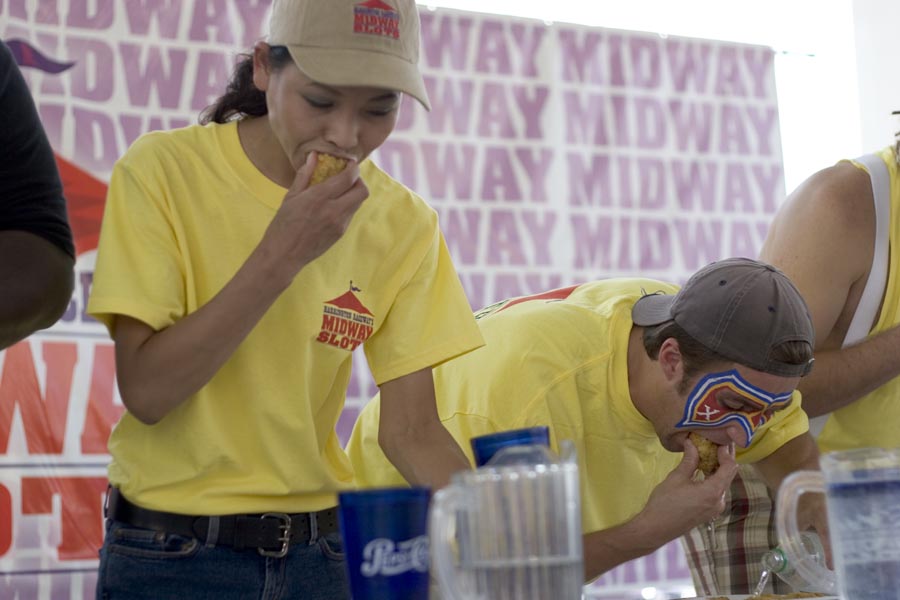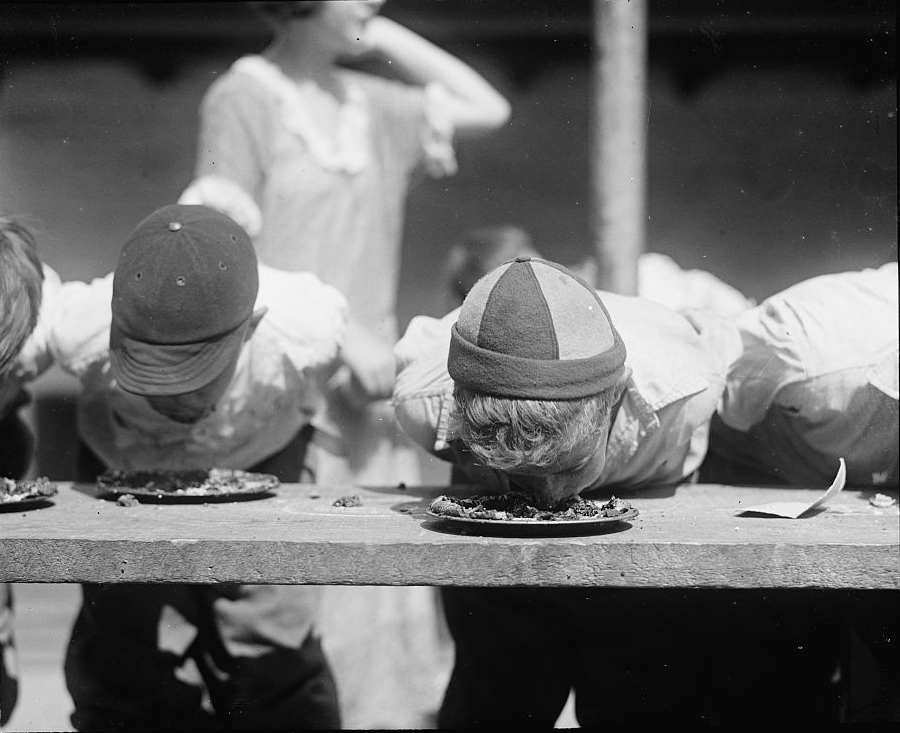|
Eat This Book
''Eat This Book'' is a book by Ryan Nerz which explores the world of competitive eating. Published by St. Martin's Press in 2006, ''Eat This Book'' provides a firsthand look into this sometimes controversial sport. Nerz, who spent a year as an emcee for the International Federation of Competitive Eating, has firsthand insight into the competitive eating phenomenon. Reviews Because Nerz's book was released in the same month as Jason Fagone's '' Horsemen of the Esophagus'', and since both books cover the sport of competitive eating, a number of published reviews covered both books together and drew comparisons between them. The strongest criticism levelled at ''Eat This Book'' in reviews is that Nerz uses prose that is more sensational than objective. Jay Jennings describes Nerz as "more mythifier than journalist", and ''Booklist ''Booklist'' is a publication of the American Library Association that provides critical reviews of books and audiovisual materials for all ages. ' ... [...More Info...] [...Related Items...] OR: [Wikipedia] [Google] [Baidu] |
Ryan Nerz
Alfred Ryan Nerz is an American gonzo journalist from Columbus, Indiana. He is also an author of two books that were featured in The New York Times Book review and Entertainment Weekly. Career He freelanced for NPR, Esquire, History channel and Huffpost. He also wrote for several other media outlets including The village voice and Time Out New York. He works for Fusion as a reporter about America’s weed subculture. Nerz joined International Federation of Competitive Eating (IFOCE - later Major League eating) as an emcee in 2003. He published his book Eat This Book after a year of working as a moderator for eating competitions. It is an account about competitive eating events that are sanctioned by Major League Eating. His book Marijuanamerica revolves around America’s current weed subculture in relation to the counterculture A counterculture is a culture whose values and norms of behavior differ substantially from those of mainstream society, sometimes diametrically o ... [...More Info...] [...Related Items...] OR: [Wikipedia] [Google] [Baidu] |
Competitive Eating
Competitive eating, or speed eating, is an activity in which participants compete against each other to eat large quantities of food, usually in a short time period. Contests are typically eight to ten minutes long, although some competitions can last up to thirty minutes, with the person consuming the most food being declared the winner. Competitive eating is most popular in the United States, Canada, and Japan, where organized professional eating contests often offer prizes, including cash. History The first recorded pie eating contest took place in Toronto in 1878. It was organised as a charity fundraising event and won by Albert Piddington. It is not known how many pies were consumed. The prize was a “Handsomely Bound Book”. Following this, eating contestsparticularly those involving piebecame popular across Canada and the United States, traditionally at county fairs. There are some notable examples of early eating contestants, such as Joe McCarthy, who consumed 31 pie ... [...More Info...] [...Related Items...] OR: [Wikipedia] [Google] [Baidu] |
2006 In Literature
This article contains information about the literary events and publications of 2006. Events *March – The first full-length original novel in the Manx language, ''Dunveryssyn yn Tooder-Folley'' ("The Vampire Murders") is published by Brian Stowell, after being serialized in the press. *April 7 – Justice Peter Smith concludes in a case of February 27 in the London High Court of Justice against the publisher Random House over the bestselling novel ''The Da Vinci Code'' (2003), that the author, Dan Brown, has not breached the copyright of Michael Baigent and Richard Leigh in their ''The Holy Blood and the Holy Grail'' (1982, non-fiction). The judgment also contains a coded message on the whim of the judge. *April 7– 9 – First Jaipur Literature Festival held in India. *Summer – Brutalism becomes the first literary movement to be launched through the social networking site Myspace. *June 14 – Ciaran Creagh's play ''Last Call'', based loosely on the hanging of the m ... [...More Info...] [...Related Items...] OR: [Wikipedia] [Google] [Baidu] |
Hardcover
A hardcover, hard cover, or hardback (also known as hardbound, and sometimes as case-bound) book is one bound with rigid protective covers (typically of binder's board or heavy paperboard covered with buckram or other cloth, heavy paper, or occasionally leather). It has a flexible, sewn spine which allows the book to lie flat on a surface when opened. Modern hardcovers may have the pages glued onto the spine in much the same way as paperbacks. Following the ISBN sequence numbers, books of this type may be identified by the abbreviation Hbk. Hardcover books are often printed on acid-free paper, and they are much more durable than paperbacks, which have flexible, easily damaged paper covers. Hardcover books are marginally more costly to manufacture. Hardcovers are frequently protected by artistic dust jackets, but a "jacketless" alternative has increased in popularity: these "paper-over-board" or "jacketless" hardcover bindings forgo the dust jacket in favor of printing the cove ... [...More Info...] [...Related Items...] OR: [Wikipedia] [Google] [Baidu] |
Paperback
A paperback (softcover, softback) book is one with a thick paper or paperboard cover, and often held together with adhesive, glue rather than stitch (textile arts), stitches or Staple (fastener), staples. In contrast, hardcover (hardback) books are bound with cardboard covered with cloth, leather, paper, or plastic. Inexpensive books bound in paper have existed since at least the 19th century in such forms as pamphlets, yellow-backs, yellowbacks, dime novels, and airport novels. Modern paperbacks can be differentiated from one another by size. In the United States, there are "mass-market paperbacks" and larger, more durable "trade paperbacks". In the United Kingdom, there are A-format, B-format, and the largest C-format sizes. Paperback editions of books are issued when a publisher decides to release a book in a low-cost format. Lower-quality paper, glued (rather than stapled or sewn) bindings, and the lack of a hard cover may contribute to the lower cost of paperbacks. Paperb ... [...More Info...] [...Related Items...] OR: [Wikipedia] [Google] [Baidu] |
Competitive Eating
Competitive eating, or speed eating, is an activity in which participants compete against each other to eat large quantities of food, usually in a short time period. Contests are typically eight to ten minutes long, although some competitions can last up to thirty minutes, with the person consuming the most food being declared the winner. Competitive eating is most popular in the United States, Canada, and Japan, where organized professional eating contests often offer prizes, including cash. History The first recorded pie eating contest took place in Toronto in 1878. It was organised as a charity fundraising event and won by Albert Piddington. It is not known how many pies were consumed. The prize was a “Handsomely Bound Book”. Following this, eating contestsparticularly those involving piebecame popular across Canada and the United States, traditionally at county fairs. There are some notable examples of early eating contestants, such as Joe McCarthy, who consumed 31 pie ... [...More Info...] [...Related Items...] OR: [Wikipedia] [Google] [Baidu] |
International Federation Of Competitive Eating
Major League Eating (MLE) is an organization that organises professional competitive eating events and television specials. The stated mission of Major League Eating is to maintain a safe environment for all events, to create a dynamic and enjoyable fan experience, and to help sponsors develop, publicize and execute eating events in a wide variety of food disciplines. The league airs its annual Nathan's Famous Fourth of July International Hot Dog Eating Contest on ESPN. Brothers George and Richard Shea took over Nathan's publicity in the mid-1990s and were able to increase the exposure and attendance of Nathan's hot dog eating contest. Seeing a business opportunity, the brothers founded ''International Federation of Competitive Eating'' (IFOCE) in 1997 as a sanctioning body to oversee/regulate/organize events/TV deals. The primary professional league is known as Major League Eating. Major League Eating coordinates events in the United States and Canada. History The Internation ... [...More Info...] [...Related Items...] OR: [Wikipedia] [Google] [Baidu] |
Jason Fagone
Jason Fagone is an American journalist and author. His work has appeared in '' GQ'', ''Wired'', ''Esquire'', ''The Atlantic'', ''New York'', ''Grantland'', ''The New York Times'', and the ''Huffington Post Highline'', among other outlets. In 2002, the ''Columbia Journalism Review'' named him one of "Ten Young Writers on the Rise". He currently writes investigative stories for ''The San Francisco Chronicle''. Career His first book, ''Horsemen of the Esophagus'', is about competitive eating. Of the sport-like activity, Fagone writes, "You hate to see all these very clear human desires poured into something like an eating contest. But it’s kind of inspiring that we’re creative enough and resilient enough to make it work. It’s both an American horror show and an American success story." His second book, ''Ingenious: A True Story Of Invention, Automotive Daring, And The Race To Revive America'' is about teams in the Progressive Automotive X PRIZE, including Edison2 (Very Light C ... [...More Info...] [...Related Items...] OR: [Wikipedia] [Google] [Baidu] |
Horsemen Of The Esophagus
''Horsemen of the Esophagus'' by Jason Fagone is a nonfiction book about the sport of competitive eating and the outsized American appetite. ''Horsemen'' follows three American "gurgitators" during a year on the pro eating circuit: Ohio housepainter David "Coondog" O'Karma, South Jersey truck driver Bill "El Wingador" Simmons, and Manhattan day-trader Tim "Eater X" Janus. ''Horseman'' makes stops at 27 competitive eating contests around the world, including the Nathan's Famous Hot Dog Eating Contest at Coney Island and includes an interview with Nathan's champion at the time, Takeru Kobayashi , also known as Takeru "Tsunami" Kobayashi, is a Japanese competitive eater. Described as "the godfather of competitive eating", Kobayashi is a six-time champion of Nathan's Hot Dog Eating Contest and is widely credited with popularizing the spor .... Further reading *''Horsemen of the Esophagus'' by Jason Fagone, * Book excerpt (subscription only). * Book review. Competitive ... [...More Info...] [...Related Items...] OR: [Wikipedia] [Google] [Baidu] |
Booklist
''Booklist'' is a publication of the American Library Association that provides critical reviews of books and audiovisual materials for all ages. ''Booklist''s primary audience consists of libraries, educators, and booksellers. The magazine is available to subscribers in print and online. ''Booklist'' is published 22 times per year, and reviews over 7,500 titles annually. The ''Booklist'' brand also offers a blog, various newsletters, and monthly webinars. The ''Booklist'' offices are located in the American Library Association headquarters in Chicago’s Gold Coast neighborhood. History ''Booklist'', as an introduction from the American Library Association publishing board notes, began publication in January 1905 to "meet an evident need by issuing a current buying list of recent books with brief notes designed to assist librarians in selection." With an annual subscription fee of 50 cents, ''Booklist'' was initially subsidized by a $100,000 grant from the Carnegie Foundation, ... [...More Info...] [...Related Items...] OR: [Wikipedia] [Google] [Baidu] |
Infomercial
An infomercial is a form of television commercial that resembles regular TV programming yet is intended to promote or sell a product, service or idea. It generally includes a toll-free telephone number or website. Most often used as a form of direct response television (DRTV), they are often ''program-length commercials'' (long-form infomercials), and are typically 28:30 or 58:30 minutes in length. Infomercials are also known as paid programming (or teleshopping in Europe). This phenomenon started in the United States, where infomercials were typically shown overnight (usually 1:00 a.m. to 6:00 a.m.), outside peak prime time hours for commercial broadcasters. Some television stations chose to air infomercials as an alternative to the former practice of signing off, while other channels air infomercials 24 hours a day. Some stations also choose to air infomercials during the daytime hours, mostly on weekends, to fill in for unscheduled network or syndicated programming. By ... [...More Info...] [...Related Items...] OR: [Wikipedia] [Google] [Baidu] |


